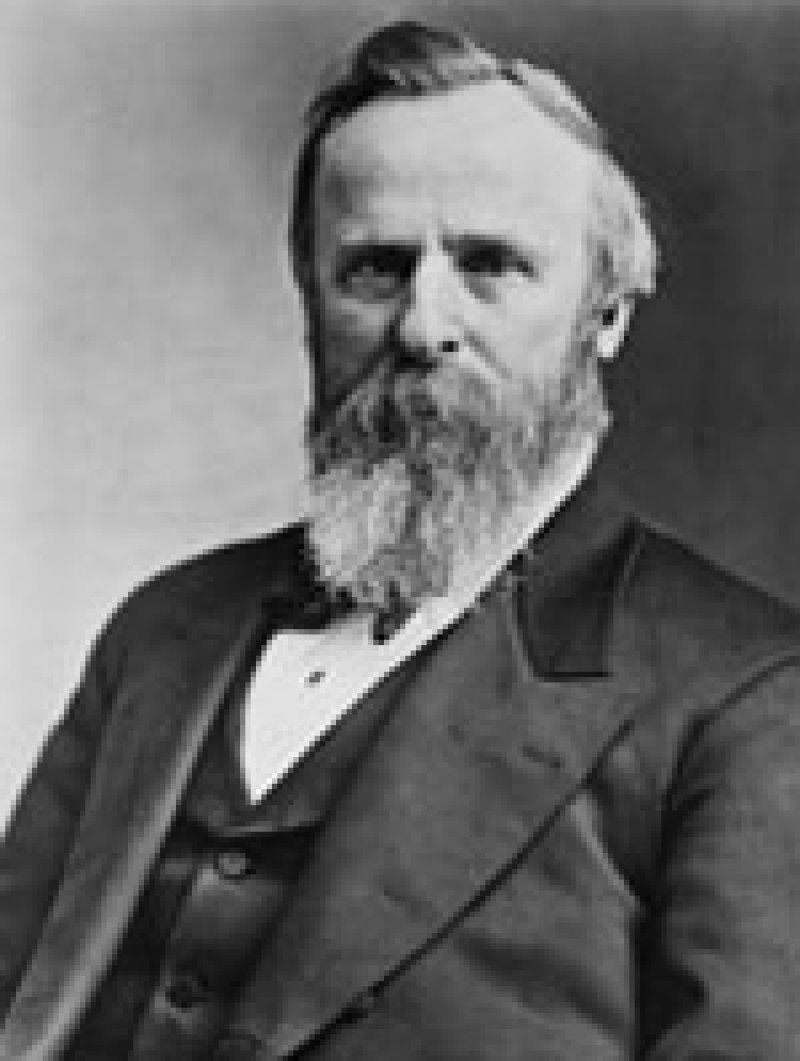Rutherford Birchard Hayes (Oct. 4, 1822 - Jan. 17, 1893)
Rutherford Birchard Hayes, 19th president of the United States, was born in Delaware, Ohio. In 1838 Hayes entered Kenyon College at Gambier, Ohio, and in 1842 graduated at the head of his class. After a disappointing year of reading law in Columbus, he entered the Harvard Law School, studied under Simon Greenleaf and Supreme Court Justice Joseph Story, and received his bachelor of laws degree in 1845.
Hayes first practiced law in Birchard's little town of Lower Sandusky (now Fremont), Ohio, but in 1850 he moved to Cincinnati.
Beginning in 1853 Hayes defended runaway slaves, and later, seeking to prevent the spread of slavery into western territories, he joined the Republican Party. From 1858 to 1861 Hayes served as Cincinnati's city solicitor. The attack of Fort Sumter on April 12, 1861, however, infuriated him. On June 27, he was commissioned a major in the 23rd Ohio Volunteer Infantry. An inspirational leader in battle, Hayes served four years, was wounded five times, was brevetted major general and emerged from the war a member of Congress.
In 1867 Hayes resigned from Congress to run for governor of Ohio. He was elected and served two terms from 1868 to 1872. He was primarily responsible for the ratification by Ohio of the 15th Amendment and for the establishment of the Ohio State University.
Obnoxious to no one, Hayes recognized that availability was his strength and did little to secure the nomination for president in 1876. When more powerful candidates failed, availability worked, and Hayes received the nomination.
In deciding issues, Hayes was principled yet practical, cautious yet courageous. Once he made up his mind he was firm and consistent. He did not panic under stress, endured criticism and hostility, was slow to anger and bore few grudges. He was a patient reformer, confident that ultimately his goals would be achieved. Because of these attitudes, Hayes succeeded so far as the circumstances of his presidency allowed.
For those experiencing hard times, Reconstruction and corruption were not important issues. Wage cuts, unemployment, and shrinking incomes led to the Great Railroad Strike of 1877, to agitation against Chinese laborers in California and to demands for currency expansion. The reaction of Hayes to these problems was tempered by moderation and practicality. His restrained, legalistic response to the Great Strike saved lives and property.
Near the end of his administration, Hayes claimed that his hard-money stance and especially the resumption of specie payments, which in January 1879 placed the United States back on the gold standard, had restored the confidence of investors and the business community. With abundant capital and low interest rates, industries were thriving, railroads expanding, and foreign trade increasing.
Although his southern policy failed to secure obedience to the Reconstruction amendments, Hayes never abandoned his commitment to civil rights and to equal educational and economic opportunities for all Americans. He was conscientious, humane and just. He urged that federal subsidies be given to poor states and territories so that all children could receive a quality education.
In retirement Hayes vigorously advocated a larger role for the federal government in promoting the public welfare. Having as president signed the Arrears of Pension Act (1879), he continued his fight to better support needy veterans. His denunciation of giant monopolistic corporations and his support of federal regulation of industry (for example, the 1887 Interstate Commerce Act), make Hayes a precursor of progressivism.
Believing that education would ultimately cure most of the problems in American society, Hayes made it his hobby. Even when president, he was a conscientious trustee of the Peabody Fund, which supported the education of southern blacks and whites.
A few months after his 70th birthday, an attack of angina pectoris felled him in Cleveland, where he was on Ohio State University business. The pain was intense, but, after some brandy, he insisted on returning home to Spiegel Grove, where he died.
Some content and graphic elements featured on webpages related to the Thomas J. Moyer Ohio Judicial Center were used with the permission of the Ohio Historical Society; the Prints and Photographs Division of the Library of Congress; the Office of the Curator of the Supreme Court of the United States and American National Biography Online.
Biography of Rutherford B. Hayes (Oct. 4, 1822 - Jan. 17, 1893)
Citation: Ari Hoogenboom. "Hayes, Rutherford Birchard"; http://www.anb.org/articles/05/05-00331.html; American National Biography Online Feb. 2000. Access Date: Fri Oct 3 09:47:03 2003. Copyright © 2000 American Council of Learned Societies. Published by Oxford University Press. All Rights Reserved.
Portrait of Rutherford B. Hayes - Library of Congress, Prints & Photographs Division.

